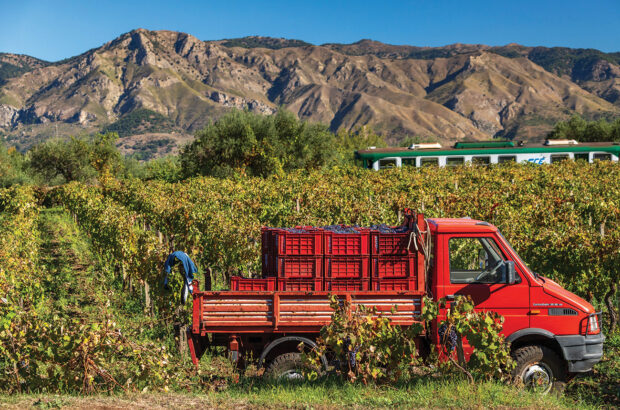Following much debate over several years, in the summer of 2021 the Chianti Classico consorzio approved a new sub-zone classification, the proposal having been to allow 11 Unità Geografiche Aggiuntive (UGAs: ‘additional geographical units’) in Chianti Classico to add the name of their commune or township to the front label of their Gran Selezione wines (in the coming years this will extend to the Riserva and annata-level wines).
The approval of this law change, said to be by a ‘very large majority’ of the governing consorzio’s members, has encouraged producers in those sub-zones to gather together to form their own member associations, in order to unify, define and promote their own zone.
Chianti Classico is the historic centre of Chianti production, spanning some 70,000ha of territory between the Tuscan cities of Florence and Siena, 10% of which is planted to vines. Sangiovese dominates here, as it has to make up at least 80% of the blend for all Chianti Classico wines.
Scroll down to see tasting notes and scores for eight top wines from Chianti Classico’s new sub-zones
{"content":"PHA+VG8gaGF2ZSBtb3JlIHByZWNpc2UgaW5mb3JtYXRpb24gcmVnYXJkaW5nIHRoZSBvcmlnaW4gb2YgdGhlIHdpbmVzIHdpbGwgYmUgZ3JlYXRseSBiZW5lZmljaWFsLCBiZWxpZXZlcyBEYXZpZCBHbGVhdmUgTVcsIGNoYWlybWFuIG9mIGltcG9ydGVyIExpYmVydHkgV2luZXMgaW4gdGhlIFVLLjwvcD4KPHA+U2FuZ2lvdmVzZSwgbGlrZSBQaW5vdCBOb2lyLCBpcyBhIHNpdGUtc2Vuc2l0aXZlIHZhcmlldHkgYW5kIGV4cHJlc3NlcyBiZWF1dGlmdWxseSB0aGUgbnVhbmNlIG9mIHBsYWNlLCBzbyB0aGUgbmV3IG1vdmUgZ2l2ZXMgdGhlIGNvbnN1bWVyIG1vcmUgb3Bwb3J0dW5pdHkgdG8gdW5kZXJzdGFuZCB0aGF0IHNwZWNpZmljIHBsYWNlIHRocm91Z2ggdGhlIHdpbmUsIGhlIGFyZ3Vlcy48L3A+CjxwPjxkaXYgY2xhc3M9ImFkLWNvbnRhaW5lciBhZC1jb250YWluZXItLW1vYmlsZSI+PGRpdiBpZD0icG9zdC1pbmxpbmUtMiIgY2xhc3M9ImlwYy1hZHZlcnQiPjwvZGl2PjwvZGl2PjwvcD4KPHA+SXQgaXMgYSBjaGFsbGVuZ2UgdG8gZXhwbGFpbiBuZWF0bHkgdGhlIGRldGFpbGVkIHF1YWxpdGllcyBvZiBlYWNoIHN1Yi16b25lIGludm9sdmVkIOKAkyBhbmQgdGhlcmUgYXJlIGZ1cnRoZXIgbGVnYWwgaHVyZGxlcyB0byBiZSBjcm9zc2VkIGJlZm9yZSB0aGUgY3VycmVudCBuaW5lIHJlY29nbmlzZWQgQ2hpYW50aSBDbGFzc2ljbyBjb21tdW5lIGFyZWFzIGFyZSBvZmZpY2lhbGx5IHN1cGVyc2VkZWQgYnkgdGhlIDExIG5ldyBVR0FzLiBIb3dldmVyLCBoZXJlIHdlIHNoYWxsIGdvIG9uIGEgam91cm5leSB0byB1bmRlcnN0YW5kIGluIGJyb2FkIHN0cm9rZXMgdGhlIGtleSBkaWZmZXJlbmNlcywgZnJvbSB2aWxsYWdlIHRvIHZpbGxhZ2UuPC9wPgo8ZGl2IGlkPSJhdHRhY2htZW50XzQ3MzY5OSIgc3R5bGU9IndpZHRoOiAxMzEwcHgiIGNsYXNzPSJ3cC1jYXB0aW9uIGFsaWduY2VudGVyIj48aW1nIGZldGNocHJpb3JpdHk9ImhpZ2giIGRlY29kaW5nPSJhc3luYyIgYXJpYS1kZXNjcmliZWRieT0iY2FwdGlvbi1hdHRhY2htZW50LTQ3MzY5OSIgY2xhc3M9Imxhenlsb2FkIGJsdXItdXAgc2l6ZS1mdWxsIHdwLWltYWdlLTQ3MzY5OSIgZGF0YS1wcm9jZXNzZWQgc3JjPSJodHRwczovL3d3dy5kZWNhbnRlci5jb20vd3AtY29udGVudC90aGVtZXMvc2ltYmEtdGhlbWUvYXNzZXRzL2ltYWdlcy9wbGFjZWhvbGRlci5wbmciIGRhdGEtc3JjPSJodHRwczovL2tleWFzc2V0cy50aW1laW5jdWsubmV0L2luc3BpcmV3cC9saXZlL3dwLWNvbnRlbnQvdXBsb2Fkcy9zaXRlcy8zNC8yMDIyLzAxL01hcC1vZi1uZXctQ2hpYW50aS1DbGFzc2ljby1zdWItem9uZXMuanBnIiBhbHQ9Ik1hcCBvZiBuZXcgQ2hpYW50aSBDbGFzc2ljbyBzdWItem9uZXMiIHdpZHRoPSIxMzAwIiBoZWlnaHQ9Ijg2MCIgZGF0YS1zaXplcz0iYXV0byIgZGF0YS1zcmNzZXQ9Imh0dHBzOi8va2V5YXNzZXRzLnRpbWVpbmN1ay5uZXQvaW5zcGlyZXdwL2xpdmUvd3AtY29udGVudC91cGxvYWRzL3NpdGVzLzM0LzIwMjIvMDEvTWFwLW9mLW5ldy1DaGlhbnRpLUNsYXNzaWNvLXN1Yi16b25lcy5qcGcgMTMwMHcsIGh0dHBzOi8va2V5YXNzZXRzLnRpbWVpbmN1ay5uZXQvaW5zcGlyZXdwL2xpdmUvd3AtY29udGVudC91cGxvYWRzL3NpdGVzLzM0LzIwMjIvMDEvTWFwLW9mLW5ldy1DaGlhbnRpLUNsYXNzaWNvLXN1Yi16b25lcy0zMDB4MTk4LmpwZyAzMDB3LCBodHRwczovL2tleWFzc2V0cy50aW1laW5jdWsubmV0L2luc3BpcmV3cC9saXZlL3dwLWNvbnRlbnQvdXBsb2Fkcy9zaXRlcy8zNC8yMDIyLzAxL01hcC1vZi1uZXctQ2hpYW50aS1DbGFzc2ljby1zdWItem9uZXMtNjMweDQxNy5qcGcgNjMwdywgaHR0cHM6Ly9rZXlhc3NldHMudGltZWluY3VrLm5ldC9pbnNwaXJld3AvbGl2ZS93cC1jb250ZW50L3VwbG9hZHMvc2l0ZXMvMzQvMjAyMi8wMS9NYXAtb2YtbmV3LUNoaWFudGktQ2xhc3NpY28tc3ViLXpvbmVzLTEzNXg4OS5qcGcgMTM1dywgaHR0cHM6Ly9rZXlhc3NldHMudGltZWluY3VrLm5ldC9pbnNwaXJld3AvbGl2ZS93cC1jb250ZW50L3VwbG9hZHMvc2l0ZXMvMzQvMjAyMi8wMS9NYXAtb2YtbmV3LUNoaWFudGktQ2xhc3NpY28tc3ViLXpvbmVzLTMyMHgyMTIuanBnIDMyMHcsIGh0dHBzOi8va2V5YXNzZXRzLnRpbWVpbmN1ay5uZXQvaW5zcGlyZXdwL2xpdmUvd3AtY29udGVudC91cGxvYWRzL3NpdGVzLzM0LzIwMjIvMDEvTWFwLW9mLW5ldy1DaGlhbnRpLUNsYXNzaWNvLXN1Yi16b25lcy02MjB4NDEwLmpwZyA2MjB3LCBodHRwczovL2tleWFzc2V0cy50aW1laW5jdWsubmV0L2luc3BpcmV3cC9saXZlL3dwLWNvbnRlbnQvdXBsb2Fkcy9zaXRlcy8zNC8yMDIyLzAxL01hcC1vZi1uZXctQ2hpYW50aS1DbGFzc2ljby1zdWItem9uZXMtOTIweDYwOS5qcGcgOTIwdywgaHR0cHM6Ly9rZXlhc3NldHMudGltZWluY3VrLm5ldC9pbnNwaXJld3AvbGl2ZS93cC1jb250ZW50L3VwbG9hZHMvc2l0ZXMvMzQvMjAyMi8wMS9NYXAtb2YtbmV3LUNoaWFudGktQ2xhc3NpY28tc3ViLXpvbmVzLTEyMjB4ODA3LmpwZyAxMjIwdyIgc2l6ZXM9IihtYXgtd2lkdGg6IDEzMDBweCkgMTAwdncsIDEzMDBweCIgLz48cCBpZD0iY2FwdGlvbi1hdHRhY2htZW50LTQ3MzY5OSIgY2xhc3M9IndwLWNhcHRpb24tdGV4dCI+Q3JlZGl0OiBNYWdnaWUgTmVsc29uIC8gRGVjYW50ZXI8L3A+PC9kaXY+Cjxocj4KPGgzIHN0eWxlPSJ0ZXh0LWFsaWduOiBjZW50ZXI7Ij48c3Ryb25nPlNlZSBhbHNvOiA8YSBocmVmPSJodHRwczovL3d3dy5kZWNhbnRlci5jb20vcHJlbWl1bS9jaGlhbnRpLXJ1ZmluYS1yZWdpb25hbC1wcm9maWxlLXBsdXMtdG9wLXdpbmVzLXdvcnRoLXNlZWtpbmctb3V0LTQ2NzIyNS8iIHRhcmdldD0iX2JsYW5rIiByZWw9Im5vb3BlbmVyIG5vcmVmZXJyZXIiPkNoaWFudGkgUsO5ZmluYTogcmVnaW9uYWwgcHJvZmlsZSBwbHVzIHRvcCB3aW5lcyB3b3J0aCBzZWVraW5nIG91dDwvYT48L3N0cm9uZz48L2gzPgo8aHI+CjxoMj5TdGFydGluZyBpbiB0aGUgc291dGg6IFZhZ2xpYWdsaTwvaDI+CjxwPkEgMTUtbWludXRlIGRyaXZlIG5vcnRoIGZyb20gdGhlIGNlbnRyZSBvZiBTaWVuYSwgVmFnbGlhZ2xpIGlzIGEgaGFtbGV0IHdpdGhpbiB0aGUgY29tbXVuZSBvZiBDYXN0ZWxudW92byBCZXJhcmRlbmdhLiBXaW5lcmllcyBoZXJlIHdpbGwgYmUgYWJsZSB0byBhZGQgdGhlIHZpbGxhZ2UgbmFtZSDigJhWYWdsaWFnbGnigJkgdG8gdGhlaXIgbGFiZWwg4oCTIHRob3VnaCBzb21lIHByb2R1Y2VycyBhcmUgY29udGludWluZyB3aXRoIHRoZSBtb3JlIGZhbWlsaWFyIGNvbW11bmUgbmFtZSwgQ2FzdGVsbnVvdm8gQmVyYXJkZW5nYS48L3A+CjxkaXYgY2xhc3M9ImFkLWNvbnRhaW5lciBhZC1jb250YWluZXItLW1vYmlsZSI+PGRpdiBpZD0icG9zdC1pbmxpbmUtMyIgY2xhc3M9ImlwYy1hZHZlcnQiPjwvZGl2PjwvZGl2Pgo8cD5XaXRoIENhc3RlbG51b3ZvIEJlcmFyZGVuZ2EgZm9ybWluZyBhIGJ1dHRlcmZseSBzaGFwZSBhdCB0aGUgc291dGhlcm4gZWRnZSBvZiB0aGUgQ2hpYW50aSBDbGFzc2ljbyByZWdpb24sIFZhZ2xpYWdsaSBub3cgZGVub3RlcyB0aGUg4oCYd2VzdCB3aW5n4oCZIG9mIHRoZSBidXR0ZXJmbHksIHNlcGFyYXRlZCBmcm9tIHRoZSBlYXN0IHdpbmcgb2YgQ2FzdGVsbnVvdm8gQmVyYXJkZW5nYSBieSB0aGUgQXJiaWEgcml2ZXIgYXQgUGlhbmVsbGEgYW5kIHRoZSBzdWItem9uZSBvZiBHYWlvbGUuIEFsdGl0dWRlIGJlZ2lucyB0byBjcmVlcCB1cCBhcyB5b3UgYXBwcm9hY2ggVmFnbGlhZ2xpLCBhbmQgaGVyZSB0aGUgc29pbHMgY29udGFpbiBtb3JlIGFsYmVyZXNlIChhIGNvbXBhY3QgbGltZXN0b25lIHJvY2spIGFuZCBsZXNzIGNsYXkgYW5kIHR1ZmYsIGEgc29mdCwgcG9yb3VzIHJvY2sgY3JlYXRlZCBmcm9tIHZvbGNhbmljIGFzaCwgbW9yZSBjb21tb24gaW4gQ2FzdGVsbnVvdm8gQmVyYXJkZW5nYS4gSW4gaGlzIDxlbT5JdGFseeKAmXMgTmF0aXZlIFdpbmUgR3JhcGUgVGVycm9pcnM8L2VtPiAoVUMgUHJlc3MsIEF1Z3VzdCAyMDE5KSwgSWFuIETigJlBZ2F0YSBub3RlcyB0aGF0IHRoZSB3aW5lcyBmcm9tIHRoaXMgem9uZSBhcmUg4oCYZ2VuZXJhbGx5IGxpZ2h0ZXIgYm9kaWVkLCBzdWNjdWxlbnQgYW5kIGp1aWN54oCZLjwvcD4KPHA+QXQgc2xpZ2h0bHkgbG93ZXIgYWx0aXR1ZGUgaW4gdGhlIGVhc3Qgd2luZywgQ2FzdGVsbnVvdm8gQmVyYXJkZW5nYSBpcyBhbW9uZyB0aGUgd2FybWVzdCBjb21tdW5lcyBpbiBDaGlhbnRpIENsYXNzaWNvLiBTb3V0aC1mYWNpbmcgYW5kIHN1bi1ibGVzc2VkLCB3aW5lcyBoZXJlIGFyZSBhbXBsZSBpbiBib2R5IGFuZCBkYXJrIGluIHRoZWlyIGZydWl0IGNoYXJhY3Rlciwgd2l0aCB0aWdodGx5IGtuaXQgdGFubmlucyB0aGF0IGluIHRoZWlyIHlvdXRoIGNhbiBhcHBlYXIgYXVzdGVyZS4gVGhlc2Ugd2luZXMgb2Z0ZW4gZHJhdyBjb21wYXJpc29ucyB3aXRoIHRoZSBtdXNjdWxhciB3aW5lcyBvZiBNb250YWxjaW5vLCBmdXJ0aGVyIHNvdXRoLjwvcD4KPGRpdiBjbGFzcz0iYWQtY29udGFpbmVyIGFkLWNvbnRhaW5lci0tbW9iaWxlIj48ZGl2IGlkPSJwb3N0LWlubGluZS00IiBjbGFzcz0iaXBjLWFkdmVydCI+PC9kaXY+PC9kaXY+CjxoMj5DYXN0ZWxsaW5hPC9oMj4KPHA+V2l0aCB0aGUgd2FybXRoIG9mIHRoZSBzb3V0aCBhcyBvdXIgdGhlbWUsIGFuZCBTaWVuYSBhZ2FpbiBhcyBvdXIgc3RhcnRpbmcgcG9pbnQsIGEgMTUtbWludXRlIGRyaXZlIG5vcnRod2VzdCB0YWtlcyBvbmUgdG8gQ2FzdGVsbGluYS4gRHJpdmluZyB0byBGYXR0b3JpYSBQb21vbmEsIGEgZmFtaWx5LW93bmVkIGVzdGF0ZSBzaW5jZSAxODkwLCB0aGlzIHdhcm10aCBjYW4gYmUgZmVsdCBhbmQgc2VlbjogY2FjdHVzIGZsb3dlcnMgYW5kIHByaWNrbHkgcGVhcnMgcHJvdHJ1ZGUgZnJvbSB0aGUgZHJ5IHN0b25lIHdhbGxzIG9wcG9zaXRlIHRoZSB3aW5lcnkuPC9wPgo8cD5DYXN0ZWxsaW5hIGlzIG5vdCBqdXN0IHdhcm0sIGl0IGFsc28gaGFzIG9uZSBvZiB0aGUgbG93ZXN0IGxldmVscyBvZiBhbm51YWwgcmFpbmZhbGwgaW4gQ2hpYW50aSBDbGFzc2ljbywgYWNjb3JkaW5nIHRvIETigJlBZ2F0YSwgd2hvIGZvdW5kIENhc3RlbGxpbmEgdG8gaGF2ZSBhbiBhdmVyYWdlIGFubnVhbCBwcmVjaXBpdGF0aW9uIHJhdGUgb2YgNzcwbW0sIGNvbXBhcmVkIHdpdGggOTIwbW0gaW4gR3JldmUgYW5kIDk3MG1tIGluIEdhaW9sZSwgbm90aW5nIHRoYXQg4oCYQ2FzdGVsbnVvdm8gQmVyYXJkZW5nYeKAmXMgZGF0YSBhcmUgc2ltaWxhciB0byB0aGF0IG9mIENhc3RlbGxpbmHigJkuPC9wPgo8ZGl2IGNsYXNzPSJhZC1jb250YWluZXIgYWQtY29udGFpbmVyLS1tb2JpbGUiPjxkaXYgaWQ9InBvc3QtaW5saW5lLTUiIGNsYXNzPSJpcGMtYWR2ZXJ0Ij48L2Rpdj48L2Rpdj4KPHA+VGhlIGZydWl0IGNoYXJhY3RlciBvZiB0aGUgd2luZXMgaXMgdW5zdXJwcmlzaW5nbHkganVpY3ksIGNvbmNlbnRyYXRlZCBhbmQgcmlwZSwgaG93ZXZlciB0aGUgd2luZXMgZG8gbm90IHRlbmQgdG8gZmlsbCB0aGUgbW91dGggc28gYnJvYWRseSBhcyBkbyB0aGUgd2luZXMgb2YgQ2FzdGVsbnVvdm8gQmVyYXJkZW5nYS48L3A+CjxoMj5TYW4gRG9uYXRvIGluIFBvZ2dpbzwvaDI+CjxwPk5vdCBmYXIgZnJvbSBDYXN0ZWxsaW5hIHRvIGl0cyBub3J0aHdlc3QsIFNhbiBEb25hdG8gaW4gUG9nZ2lvIGluY29ycG9yYXRlcyBCYXJiZXJpbm8gVmFsIGTigJlFbHNhLCBQb2dnaWJvbnNpIGFuZCBUYXZhcm5lbGxlIFZhbCBkaSBQZXNhLiBUaGUgbW9zdCB3ZXN0ZXJseSBvZiB0aGUgc3ViLXpvbmVzLCBmcm9tIGl0cyBoaWxscyAoYXQgYW4gYXZlcmFnZSBvZiAzNTBtKSB5b3UgY2FuIHNlZSB0aGUgdG93ZXJzIG9mIFNhbiBHaW1pZ25hbm8gYW5kIHRoZSBjaXR5IG9mIFZvbHRlcnJhIGF3YXkgdG8gdGhlIHNvdXRod2VzdCwgdG93YXJkcyB0aGUgY29hc3QuPC9wPgo8cD5UaGUgd2luZCBoZXJlIGhhcyBhIHBvd2VyZnVsIGNvb2xpbmcgZWZmZWN0IG9uIHRoZSB2aW5lcywgcGFydGljdWxhcmx5IGF0IG5pZ2h0LCBmaXhpbmcgY29sb3VyLCBwcmVzZXJ2aW5nIGFjaWRpdHkgYW5kIGhlaWdodGVuaW5nIGFyb21hdGljcyBpbiB0aGUgZ3JhcGVzLiBMYXVyYSBCaWFuY2hpIG9mIENhc3RlbGxvIE1vbnNhbnRvIHRlbGxzIG1lIHRoYXQgdGhpcyBwYXN0IHN1bW1lciwgdGhlIHRlbXBlcmF0dXJlcyB3b3VsZCBkcm9wIGJ5IDE5wrBDIGF0IG5pZ2h0LCBmcm9tIGFib3V0IDI1wrBDIHRvIDbCsEMuIFRoZSBtb2RlcmF0aW5nIGVmZmVjdCBvZiB0aGUgY29vbGluZyB3aW5kcyBhbHNvIGFsbG93cyBmb3IgYSBsb25nIHJpcGVuaW5nIHNlYXNvbiwgY3J1Y2lhbCBmb3IgdGhlIGxhdGVyLXJpcGVuaW5nIFNhbmdpb3Zlc2UuPC9wPgo8aDI+U2FuIENhc2NpYW5vIFZhbCBkaSBQZXNhPC9oMj4KPHA+Q29udGludWluZyBub3J0aCwgd2UgcmVhY2ggU2FuIENhc2NpYW5vIFZhbCBkaSBQZXNhLiBJdCBpcywgYWxvbmdzaWRlIEdyZXZlIGNvbW11bmUsIGF0IHRoZSBub3J0aGVybm1vc3QgcG9pbnQgb2YgdGhlIENoaWFudGkgQ2xhc3NpY28gem9uZSBhbmQganVzdCBtaW51dGVzIGZyb20gdGhlIGNpdHkgb2YgRmxvcmVuY2UuIE5vdGFibHksIGl0IGlzIHRoZSBzdWItem9uZSB3aGVyZSBoYXJ2ZXN0IGlzIGxpa2VseSB0byBoYXBwZW4gZmlyc3QuIFRoZSBzb2lsIGlzIHJpY2ggaW4gY2lvdHRvbGkgZGkgZml1bWUg4oCTIHNtYWxsIHBlYmJsZXMgYW5kIGxhcmdlIHNtb290aCBzdG9uZXMsIHJlbW5hbnRzIG9mIGFuY2llbnQgcml2ZXIgZGVwb3NpdHMg4oCTIGFuZCBzYW5keSBzaWx0LiBUaGUgc3RvbmVzIGhvbGQgYW5kIHJhZGlhdGUgd2FybXRoLCBlbnN1cmluZyB0aGUgdmluZXMgYWNoaWV2ZSBmdWxsIG1hdHVyYXRpb24uIFRoZSB3aW5lcyBoZXJlIGhhdmUgYSBiZWF1dGlmdWwgZmx1aWRpdHkgdG8gdGhlbSwgbGlnaHQgYW5kIGRlZnQgaW4gdGFubmlucy4gVGhlc2UgcXVhbGl0aWVzIGFyZSBzeW1wYXRoZXRpY2FsbHkgZXhwcmVzc2VkIGhlcmUgaW4gdGhlIHdpbmVzIG9mIHlvdW5nIHdpbmVtYWtlcnMgTWFkZGFsZW5hIEZ1Y2lsZSBhbmQgTWF0dGVvIFZhY2NhcmkgYXQgRmF0dG9yaWEgQ2lnbGlhbm8gZGkgU29wcmEuPC9wPgo8cD5XaGVyZSBTYW4gQ2FzY2lhbm8gbWVldHMgR3JldmUgdGhlIGFsdGl0dWRlIHJpc2VzLCBhcyBkb2VzIHRoZSB2b2x1bWUgb2YgZ2FsZXN0cm8gaW4gdGhlIHNvaWwuIEdhbGVzdHJvIGlzIGEgYnJpdHRsZSBzdG9uZSwgZmxha3kgYW5kIGNydW1ibHkg4oCTIHZlcnkgZGlmZmVyZW50IHRvIHRoZSBpbXBlbmV0cmFibGUgYWxiZXJlc2UgZm91bmQgaW4gdmluZXlhcmRzIGZ1cnRoZXIgc291dGggaW4gdGhlIHJlZ2lvbi4gSXQgaXMgc2FpZCB0byByZWxlYXNlIHByZWNpb3VzIGVsZW1lbnRzIGludG8gdGhlIHNvaWwgZm9yIHRoZSBwbGFudCDigJMgYW5kIHRoZSB3aW5lcyBkaXNwbGF5IGEgbW9yZSBzdGVlbHkgY2hhcmFjdGVyLCBtb3JlIG1pbmVyYWwgYW5kIHRlbnNlLjwvcD4KPGgyPkdyZXZlPC9oMj4KPHA+Q3Jvc3NpbmcgdG8gdGhlIGVhc3QgYW5kIHNwaXJhbGxpbmcgc291dGgsIHdlIGFyZSBpbiBHcmV2ZS4gVGhlIEdyZXZlIHJpdmVyIGN1dHMgdGhyb3VnaCB0aGlzIHJlZ2lvbiBhbmQgc3R5bGVzIG9mIHdpbmUgY2FuIHZhcnkgYWNjb3JkaW5nIHRvIHdoaWNoIHNpZGUgb2YgdGhlIHZhbGxleSBhbmQgYXQgd2hhdCBhbHRpdHVkZSBhIHZpbmV5YXJkIHNpdHMuIE9uIHRoZSBlYXN0ZXJuIHNpZGUgaXQgaXMgd2FybWVyOyB2aW5leWFyZHMgZmFjZSBzb3V0aCBhbmQgd2VzdCwgZW5qb3lpbmcgdGhlIHBvdGVudCBhZnRlcm5vb24gc3VuLiBIZXJlLCBqdXN0IG91dCBvZiB0b3duIHRvIHRoZSBub3J0aCwgd29ya3MgRW5nbGlzaG1hbiBUaW0gTWFubmluZyBhdCBNb250ZWNhbHZpLCBhIDNoYSBlc3RhdGUgYXQgMjAwbSB3aXRoIHNvbWUgdmVyeSBtYXR1cmUgdmluZXMgdXAgdG8gODAgeWVhcnMgb2xkLiBIaXMgd2luZXMgaGF2ZSBhbiBleHBsaWNpdCByZWQgZnJ1aXQgY2hhcmFjdGVyIGFuZCBhIGZyZXNobmVzcyBhbmQgc3dlZXRuZXNzIHRvIHRoZW0gdGhhdCByYWlzZXMgYSBzbWlsZSBmb3IgdGhlIGRyaW5rZXIuPC9wPgo8aDI+TW9udGVmaW9yYWxsZTwvaDI+CjxwPkx5aW5nIGp1c3Qgd2VzdCBvZiBNb250ZWNhbHZpLCBhYm92ZSBHcmV2ZSB0b3duLCBhcmUgdGhlIHZpbmV5YXJkcyBvZiBDb250ZSBTZWJhc3RpYW4gQ2FwcG9uaSwgb2YgVmlsbGEgQ2FsY2luYWlhLiBIaXMgZmFtaWx5IGhhdmUgb3duZWQgcHJvcGVydHkgaW4gR3JldmUgc2luY2UgMTUyNCAodGhlaXIgVmlsbGEgQ2FsY2luYWlhIGlzIGp1c3Qgb3V0c2lkZSBGbG9yZW5jZSkuIEhpcyBlc3RhdGXigJlzIHZpbmV5YXJkcyBhcmUgYWxsIHdpdGhpbiB0aGUgc3ViLXpvbmUgb2YgTW9udGVmaW9yYWxsZSDigJMgdGhlIHNlY29uZCBzbWFsbGVzdCBzdWItem9uZSBhZnRlciBMYW1vbGUuIEl0cyByYXJlIGNvbWJpbmF0aW9uIG9mIHNvaWwgdHlwZXMgZm9yIEdyZXZlIOKAkyBhIG1peHR1cmUgb2YgbW9udGVtb3JlbGxvIChhbGJlcmVzZSBhbmQgZ2FsZXN0cm8tc2hhbGUpIGFuZCBzaWxsYW5vIChzaWx0c3RvbmUgYW5kIGNsYXlzdG9uZSkg4oCTIGFyZSBhbHNvIGZvdW5kIGF0IEFtYSBpbiBHYWlvbGUgYW5kIE1vbnRldmVydGluZSBpbiBSYWRkYSwgQ2FwcG9uaSBzYXlzLiBUaGUgdmluZXlhcmRzIG9mIE1vbnRlZmlvcmFsbGUgZmFjZSBlYXN0LCBhcHByZWNpYXRpbmcgbW9ybmluZyBzdW4gYW5kIGFmdGVybm9vbiBzaGFkZS4gSW4gaG90dGVyIHllYXJzIHRoZSB3aW5lcyByZXRhaW4gYSBjb29sbmVzcyBhbmQgZ3JhY2Ugd2hpY2gsIHdpdGggdGhlIGluZmx1ZW5jZSBvZiB0aGUgY2hhbGt5LCBsaW1lc3RvbmUtcmljaCBzb2lsLCBtYWtlcyBmb3IgZWFzZSBvZiBkcmlua2luZyBpbiB5b3V0aCBidXQgYWxzbyBhbGxvd3MgdGhlbSB0byBhZ2UgYmVhdXRpZnVsbHkuPC9wPgo8aDI+UGFuemFubzwvaDI+CjxwPkEgdG93bnNoaXAgd2l0aGluIEdyZXZlLCBQYW56YW5vIG5vdyBoYXMgaXRzIG93biBzdWItem9uZSB0byB0aGUgd2VzdCBvZiB0aGUgR3JldmUgcml2ZXIgYXQgYSBoaWdoIGFsdGl0dWRlIG9mIGFib3V0IDUwMG0uIEluIFBhbnphbm8sIHNvdXRoLWZhY2luZyB2aW5leWFyZHMgbGluZSB0aGUgZm9ybSBvZiBhIG5hdHVyYWwgYW1waGl0aGVhdHJlLXNoYXBlZCBiYXNpbiBrbm93biBhcyB0aGUg4oCYQ29uY2EgZOKAmU9yb+KAmS4gVGhlIHZpbmVzIGFyZSBiYXRoZWQgaW4gc3VubGlnaHQgYW5kIGhlYXQgZHVyaW5nIHRoZSBkYXksIGFuZCB0aGFua3MgdG8gdGhlaXIgaGlnaCBhbHRpdHVkZSBlbmpveSB0aGUgZHJvcCBpbiB0ZW1wZXJhdHVyZSBhcyBuaWdodCBiZWNvbWVzIGR1bHkgY29vbC4gUGFuemFubyB3aW5lcywgYWx3YXlzIGRlbGljaW91c2x5IHJpcGUgYW5kIGZ1bGwgaW4gYm9keSwgc2hvdyBncmVhdCBiYWxhbmNlIGFuZCBzdXBwbGVuZXNzIHdpdGggY2hld3ksIHNhdGlzZnlpbmcgdGFubmlucyBhbmQgZmxhdm91cnNvbWUgcGx1bSBhbmQgY2hlcnJ5IGZydWl0IGZsYXZvdXJzLjwvcD4KPGgyPkxhbW9sZTwvaDI+CjxwPk9ubHkgYSA3a20gZHJpdmUgYXdheSwgYW5kIHN0aWxsIHdpdGhpbiB0aGUgbXVuaWNpcGFsaXR5IG9mIEdyZXZlLCB0aGVyZSBpcyBMYW1vbGUuIEFsb25nIHdpdGggUmFkZGEsIExhbW9sZSBpcyBvbmUgb2YgdGhlIGhpZ2hlc3Qgc2l0ZXMgd2l0aGluIHRoZSBDaGlhbnRpIENsYXNzaWNvIHpvbmUsIHJpc2luZyB1cCB0byA2NTBtLiBUaGVyZSBhcmUgdmluZXlhcmRzIGhlcmUgd2l0aCB2aW5lcyB0cmFpbmVkIHRvIHN0YWtlcywgYW5kIGRyeSBzdG9uZSB0ZXJyYWNlcyBzbmFraW5nIGRvd24gc3RlZXAsIHNhbmR5LXNvaWxlZCBoaWxscy4gVGhlIGdyb3dpbmcgc2Vhc29uIGlzIGxvbmcgYmVjYXVzZSBvZiB0aGUgY29vbGVyIGF2ZXJhZ2UgdGVtcGVyYXR1cmVzLCBhbmQgdGhlIHdpbmVzIGFyZSBmaW5lOiBzbGVuZGVyIHlldCBwZXJzaXN0ZW50IGluIHRhbm5pbnMsIGxvbmcgaW4gZmxhdm91ciBhbmQgbmVydnkgaW4gYWNpZGl0eSwgdGhleSBzZWVtIHRvIHZpYnJhdGUgd2l0aCBlbmVyZ3kuPC9wPgo8aDI+UmFkZGE8L2gyPgo8cD5Nb3Zpbmcgc291dGggaW4gdGhlIGRpcmVjdGlvbiBvZiBTaWVuYSwgYnV0IHN0aWxsIGF0IGFuIGFsdGl0dWRlIG9mIDYwMG0sIHdlIGFycml2ZSBhdCBSYWRkYS4gVGhlIG1lZGlldmFsIHdhbGxlZCB0b3duIHdpdGggcGFub3JhbWljIHZpZXdzIG9mIHRoZSBzdXJyb3VuZGluZyBjb3VudHJ5c2lkZSAocGljdHVyZWQgYmVsb3cpIGlzIGdsb3Jpb3VzbHkgYXRtb3NwaGVyaWMsIGFuZCB0aGF0IHNlbnNlIG9mIGF0bW9zcGhlcmUgdW5kb3VidGVkbHkgdHJhbnNsYXRlcyBpbnRvIHRoZSBzdWItem9uZeKAmXMgd2luZXMuIFJpY2ggaW4gZGV0YWlsLCB0aGV5IHJlYWQgb24gdGhlIHBhbGF0ZSBsaWtlIGFuIGlsbHVtaW5hdGVkIG1hbnVzY3JpcHQuIFRhbm5pbnMgdGhyZWFkIHRocm91Z2gsIG5lYXRseSB3b3ZlbjsgYSBiZWF1dGlmdWwgcHJlc2VuY2UgYnV0IHdlaWdodGxlc3MsIGxpa2UgZ29sZCBsZWFmLiBUaGUgcGVyZnVtZSBvZiBSYWRkYSB3aW5lcyBpcyBoZWFkeSwgYXJvbWF0aWMgYW5kIGNvbG91cmZ1bCDigJMgb2YgcHVycGxlIGZsb3dlcnMsIGlyaXMgYW5kIHZpb2xldCwgb2YgYmxvb2Qgb3JhbmdlLCByZWQgY2hlcnJpZXMgYW5kIHN3ZWV0IHRoeW1lLjwvcD4KPGgyPkdhaW9sZTwvaDI+CjxkaXYgY2xhc3M9ImluamVjdGlvbiI+PC9kaXY+CjxwPldlIGJyaW5nIG91ciB0b3VyIHRvIGEgY2xvc2UgaW4gdGhlIHN1Yi16b25lIHdoaWNoIOKAmGlzIG1vcmUgQ2xhc3NpY28gdGhhbiB0aG914oCZLCBhcyBOaWNob2xhcyBCZWxmcmFnZSBNVyB3cm90ZSBpbiBUaGUgRmluZXN0IFdpbmVzIG9mIFR1c2NhbnkgJmFtcDsgQ2VudHJhbCBJdGFseSAoQXVydW0sIDIwMDkpLiBJbiB0aGlzIHN1Yi16b25lIHRoZXJlIGlzIENhc3RlbGxvIGRpIEJyb2xpbywgdGhlIGVzdGF0ZSBhdCB3aGljaCBCYXJvbiBCZXR0aW5vIFJpY2Fzb2xpIGluIDE4NzIgZm9ybXVsYXRlZCB0aGUgcmVjaXBlIGZvciBDaGlhbnRpLiBMaWtlIFJhZGRhLCBHYWlvbGUgaXMgYWxzbyBhdG1vc3BoZXJpYywgcnVnZ2VkIGFuZCByb2NreS4gSSBtZWV0IHdpbmVtYWtlciBNYXVyaXppbyBBbG9uZ2ksIEdhaW9sZSBib3JuIGFuZCBicmVkLiBIZSBoYXMgd29ya2VkIGluIHRoZSByZWdpb24gc2luY2UgdGhlIDE5OTBzLCBpbml0aWFsbHkgaW4gYSBjb29wZXJhdGl2ZSBpbiB0b3duIGJlZm9yZSBidXlpbmcgdGhlIDEuM2hhIEJhcmJpc2NoaW8gdmluZXlhcmQgZnJvbSBhIGxvY2FsIGNlbnRlbmFyaWFuIHdobyBwbGFudGVkIHRoaXMgdmluZXlhcmQgYWdlZCA1MC4gVGhlc2UgYXJlIGludGVudCwgdmVydGljYWwgd2luZXMg4oCTIHRoZSB0YW5uaW5zIGFyZSBtYWduaWZpY2VudDogc3VzdGFpbmVkIGJ5IHRoZSBhY2lkaXR5LCB0aGV5IGFyZSBwb2xpc2hlZCBhbmQgcGVyc2lzdGVudC4gSSBmaW5kIG15c2VsZiBjYXB0aXZhdGVkIGJ5IHRoZSBzdHJ1Y3R1cmFsIGNvbXBvbmVudHMgb2YgdGhlIHdpbmUuPC9wPgo8cD5Ib3cgZ2xvcmlvdXMgaXQgaXMgdG8gYmUgYXQgdGhlIGJlZ2lubmluZyBvZiB0aGUgQ2hpYW50aSBDbGFzc2ljbyBzdWItem9uZSBjb252ZXJzYXRpb24sIHRvIHdhdGNoLCB3YWl0LCBzd2lybCBhbmQgdGFzdGUgdGhlIGF0dGVtcHRzIG9mIHdpbmVtYWtlcnMgaGVyZSB0byBkZWNpcGhlciB0aGVpciBzaXRlcyB0aHJvdWdoIOKAkyBhcyBFbm9nZWEgcHVibGlzaGVyIGFuZCBleHBlcnQgbWFwIG1ha2VyIEFsZXNzYW5kcm8gTWFzbmFnaGV0dGkgZXhwcmVzc2VzIGl0IOKAkyB0aGF0IOKAmGV4Y2VwdGlvbmFsIGFuZCBkZW1hbmRpbmcmIzgyMzA7IFNhbmdpb3Zlc2XigJkuPC9wPgo8cD4K"}
Wines to try from Chianti Classico’s new sub-zones:
{}
{"wineId":"55742","displayCase":"standard","paywall":true}
{"wineId":"55744","displayCase":"standard","paywall":true}
{"wineId":"55747","displayCase":"standard","paywall":true}
{"wineId":"55746","displayCase":"standard","paywall":true}
{"wineId":"55741","displayCase":"standard","paywall":true}
{"wineId":"55745","displayCase":"standard","paywall":true}
{"wineId":"55740","displayCase":"standard","paywall":true}
{"wineId":"55743","displayCase":"standard","paywall":true}
{}
Related content:












